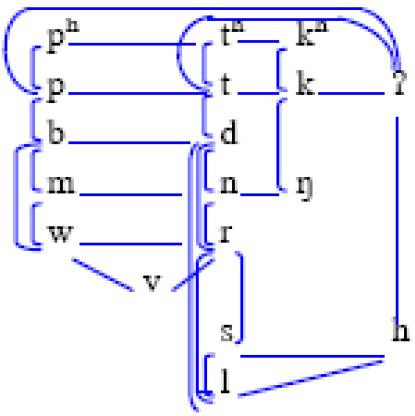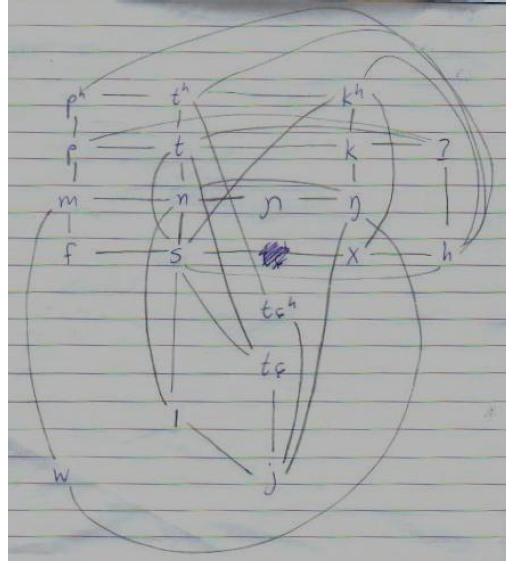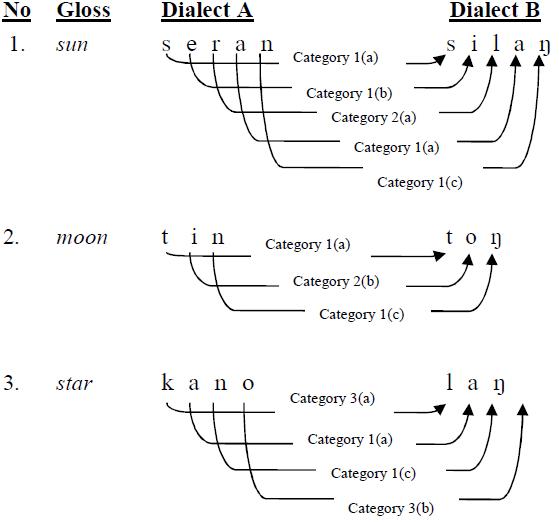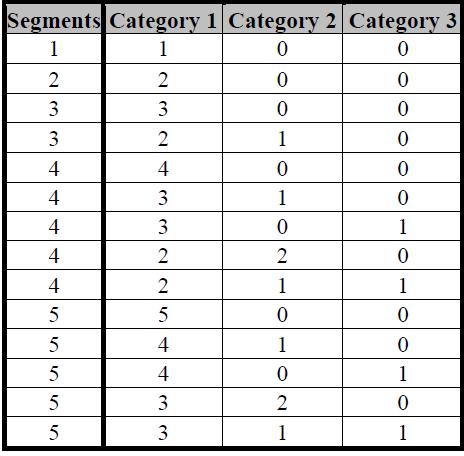Blair Method
Contents
Introduction
A method for analysing data from Word Lists which takes the middle ground between the The Comparative Method and simple inspection has been developed in South Asia. It's based on the method outlined in Frank Blair's 1990 book Survey on a Shoestring.<ref name="blair" />
Basis of the Method
The basis of this method is the segment. A segment is a phoneme unit e.g. an initial phoneme. The corresponding segments in a pair of words are analysed and placed in the following categories.
- Category 1
- Exact matches (e.g., [b] occurs in the same position in each word.)
- Vowels which differ by only one phonological feature (e.g., [i] and [e] occur in the same position in each word.)
- Phonetically similar segments which occur consistently in the same position in three or more word pairs. For example, the [g]/[gɦ] correspondences in the following entries from these two dialects would be considered category one:
| Gloss | Dialect One | Dialect Two |
|---|---|---|
| Fingernail | [goru] | [gɦoru] |
| Axe | [godeli] | [gɦodel] |
| Cloth | [guda] | [gɦuda] |
| Boy | [peka] | [pekal] |
- Category 2
- Consonant segments which are not corresponsingly similar in a certain number of pairs. The exact number of pairs needed for correspondence will vary depending on the amount of words in a list. For a list of 210 words, 3 would be reasonable. For more on this, see the page on the Significance of Sound Correspondences.
- Vowels which differ by two or more phonological features (e.g., [a] and [u]).
- Category 3
- All corresponding segments which are not phonetically similar.
- A segment which corresponds to nothing in the second word of the pair. For example, the [l]/[#] correspondence in the word for boy in the example above.
Depending on the context, you might have to allow for some localised issues. For example, SIL's South Asia survey team ignores
- Interconsonantal [ə]
- Word initial, word final, or intervocalic [h] or [ɦ]
- Any deletion
Phonetic Similarity
Notice that Blair's categories imply that you have to judge whether consonant pairs are phonetically similar or not. Additionally, you need to know what vowels differ by only one feature. So, before applying Blair’s method, you need to make charts showing what consonants you consider to be phonetically similar and what vowels you consider to differ by only one feature.
Consult a phonology text for help. The specifics will depend on the language family. Here is another place where the The Comparative Method can be useful. If you have, or another researcher has, constructed a proto-language for the language family of interest, then consult it for help as to what sorts of sound correspondences to look for. Figure 1 shows an example for consonants from surveyor Noel Mann. Phonetically similar segments are joined by a single line.
Figure 2 shows an example for vowels.
Noel notes that “the schwa is a tricky element; although the criterion says we can ignore it interconsonantally, it can be one of a number of disguised phones.” So sometimes it should be ignored, but other times included in the comparison. How can you tell the difference?
Noel says
This may vary depending on the language. I would use the general rule of ignoring schwa when it is in the onset position, that is between consonants in the onset but not when it is the nuclear element of a syllable. The reason for ignoring it in the onset is that it is often merely a transitional element and some linguists will transcribe it while others will not (this appears to be the case in many Asian languages). In this position, it is often a slight transition and not a full segment. For the nucleus however, it tends to be the remnant of a vowel at a different place on the phonetic chart (particularly in Tibeto-Burman) which has become reduced to schwa.
An example from Mpi, a Tibeto-Burman language in the Loloish branch is shown in Figures 3 and Figure 4 (Nahhas 2005)<ref name="nahhas">Nahhas, Ramzi W. 2005. Sociolinguistic survey of Mpi in Thailand. Linguistics Department Research Paper #202. Chiang Mai: Payap University.</ref>. Nahhas comments
In practice, what actually happened for Mpi was that after I had inventoried the segments and consulted a phonology text, if I encountered correspondences which seemed to be regular but were not connected by a line in the chart I added a line! “Phonetically similar” is a fuzzy concept. Sound changes that seem strange in one part of the world might be reasonable in another.
Counting Correspondences
When you do encounter a correspondence between phonetically similar segments, then you need to look through all the other words in the list (not just the 100 or so used in the comparison). Count how many times these two segments appear in the same word pair and in the same relationship (that is, count the correspondences in which one segment is always in one language and the other is always in the other). Blair says that a correspondence is considered to be “regular” if there are three or more occurrences in the data. This was based on a word list of length 210. This seems to be a good rule of thumb, and you will often be correct in using it. However, in fact, the right number to use is not three in all cases. It depends on the length of the word list and the frequency of occurrence of the segments in question. For more, refer to the Significance of Sound Correspondences page.
Table 2 provides an example of the observed sound correspondences obtained from a lexical comparison of two Mpi villages, Ban Dong and Ban Sakoen, using 436-item word list (see Nahhas 2005)<ref name="nahhas" />.
Table 2 brings up a couple of interesting points. First, for some languages, you should consider a consonant cluster as two segments, for others as one. For Mpi, they were counted as one segment. Also, occurrences of the same sound change, even with different segments, can be grouped together. For Mpi, there were three different environments (all bilabial) where a [j]-[l] correspondence occurred. These were grouped together to give a total of 10 occurrences. Thus, some single occurrences were counted as “regular” because the change in question was observed in enough other environments.
Examples of Segment Comparisons
The following example is from Noel Mann. In it, the [n]-[ŋ] correspondence is counted wherever it occurs (initially, medially, or finally).
Criteria for Lexical Similarity
Once all the segment pairs for a word pair are categorized, the following rule is applied. The rule given here has been formulated independently by a few different surveyors as a concise way of summarizing Blair’s chart. Also, this rule allows Blair’s chart to be generalized to any number of phones. For more, see the Segment Table page.
Two items are judged to be phonetically similar if:
At least 50% of the segments compared are in Category 1 AND At least 75% of the segments compared are in Category 1 and Category 2.
For one to five segments, Table 3 shows the possible combinations of segments that lead to a conclusion of lexical similarity. Any combination not in the table would not be considered lexically similar.
Let’s look again at the example from Section 4.6.3.3:
Thus, based on Table 3, two of the three pairs are considered lexically similar. <references/>







